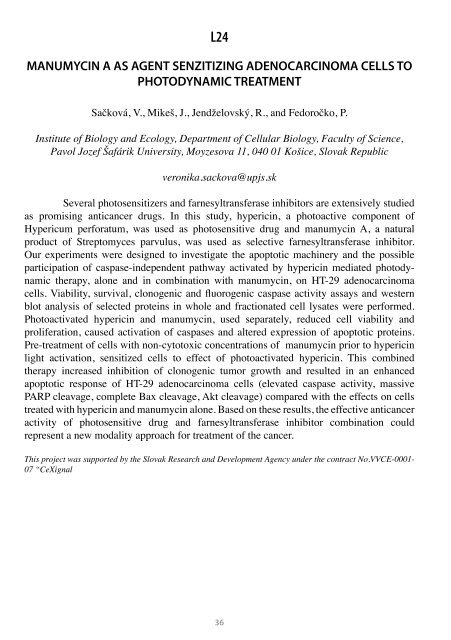Cancer Research Institute, Slovak Academy of Sciences
Cancer Research Institute, Slovak Academy of Sciences
Cancer Research Institute, Slovak Academy of Sciences
Create successful ePaper yourself
Turn your PDF publications into a flip-book with our unique Google optimized e-Paper software.
L24<br />
MANUMYCIN A AS AGENT SENZITIZING ADENOCARCINOMA CELLS TO<br />
PHOTODYNAMIC TREATMENT<br />
Sačková, V., Mikeš, J., Jendželovský, R., and Fedoročko, P.<br />
<strong>Institute</strong> <strong>of</strong> Biology and Ecology, Department <strong>of</strong> Cellular Biology, Faculty <strong>of</strong> Science,<br />
Pavol Jozef Šafárik University, Moyzesova 11, 040 01 Košice, <strong>Slovak</strong> Republic<br />
veronika.sackova@upjs.sk<br />
Several photosensitizers and farnesyltransferase inhibitors are extensively studied<br />
as promising anticancer drugs. In this study, hypericin, a photoactive component <strong>of</strong><br />
Hypericum perforatum, was used as photosensitive drug and manumycin A, a natural<br />
product <strong>of</strong> Streptomyces parvulus, was used as selective farnesyltransferase inhibitor.<br />
Our experiments were designed to investigate the apoptotic machinery and the possible<br />
participation <strong>of</strong> caspase-independent pathway activated by hypericin mediated photodynamic<br />
therapy, alone and in combination with manumycin, on HT-29 adenocarcinoma<br />
cells. Viability, survival, clonogenic and fluorogenic caspase activity assays and western<br />
blot analysis <strong>of</strong> selected proteins in whole and fractionated cell lysates were performed.<br />
Photoactivated hypericin and manumycin, used separately, reduced cell viability and<br />
proliferation, caused activation <strong>of</strong> caspases and altered expression <strong>of</strong> apoptotic proteins.<br />
Pre-treatment <strong>of</strong> cells with non-cytotoxic concentrations <strong>of</strong> manumycin prior to hypericin<br />
light activation, sensitized cells to effect <strong>of</strong> photoactivated hypericin. This combined<br />
therapy increased inhibition <strong>of</strong> clonogenic tumor growth and resulted in an enhanced<br />
apoptotic response <strong>of</strong> HT-29 adenocarcinoma cells (elevated caspase activity, massive<br />
PARP cleavage, complete Bax cleavage, Akt cleavage) compared with the effects on cells<br />
treated with hypericin and manumycin alone. Based on these results, the effective anticancer<br />
activity <strong>of</strong> photosensitive drug and farnesyltransferase inhibitor combination could<br />
represent a new modality approach for treatment <strong>of</strong> the cancer.<br />
This project was supported by the <strong>Slovak</strong> <strong>Research</strong> and Development Agency under the contract No.VVCE-0001-<br />
07 “CeXignal<br />
L25<br />
HSP90 PROTEIN AS A TARGET FOR IMPROVING PHOTODYNAMIC<br />
THERAPY<br />
Solár, P., Chytilová, M., Ferenc, P., Solárová, Z.*, and Fedoročko, P.<br />
Laboratory <strong>of</strong> Cell Biology, <strong>Institute</strong> <strong>of</strong> Biology and Ecology,<br />
Faculty <strong>of</strong> <strong>Sciences</strong>, P. J. Šafárik University, Košice, <strong>Slovak</strong> Republic<br />
*Geriatric Nursing Clinic, Faculty <strong>of</strong> Medicine, P. J. Šafárik University, Košice, <strong>Slovak</strong> Republic<br />
peter.solar@upjs.sk<br />
Our results show that photodynamic therapy (PDT) <strong>of</strong> hypericin induces the phosphorylation<br />
<strong>of</strong> Erk1,2 proteins and increases the level <strong>of</strong> survivin, which is the inhibitor <strong>of</strong><br />
apoptosis protein. Survivin is a client protein for the 90 kDa heat shock protein (Hsp90), and<br />
the binding <strong>of</strong> survivin to Hsp90 assists in the maturation, proper folding, assembly, and transport<br />
<strong>of</strong> this protein.<br />
17-(dimethylaminoethylamino)-17-demethoxygeldanamycin (17-DMAG) is a benzoquinone<br />
ansamycin antibiotic with destabilizing effect on different Hsp90 client proteins, such as Akt,<br />
HER-2, Raf kinase, survivin and others. In contrast to other geldanamycin (GA) analogues,<br />
17-DMAG has several potential advantages, e.g. water solubility, higher oral bioavailability<br />
and/or less toxic metabolites.<br />
In our study we were focusing on the determination <strong>of</strong> the 17-DMAG effect on<br />
SKBR3 breast cancer cells (overexpressing HER-2 oncogene) as well as on the response <strong>of</strong><br />
SKBR3 cells on PDT with hypericin when modulated by 17-DMAG administration. Low concentration<br />
<strong>of</strong> 17-DMAG without the effect on survival <strong>of</strong> SKBR3 cells significantly reduced<br />
metabolic activity (MTT assay), viability and cellularity <strong>of</strong> SKBR3 cells induced 24 and 48<br />
h after PDT by hypericin. Moreover, we observed a significant decrease <strong>of</strong> SKBR3 cells in<br />
S phase as well as an increase in G1 phase <strong>of</strong> the cell cycle after 24h treatment with IC10<br />
concentration <strong>of</strong> 17-DMAG and an increase in G2 phase <strong>of</strong> SKBR3 cells when 17-DMAG<br />
was combined with PDT. Furthermore, IC50 concentration <strong>of</strong> 17-DMAG induced decrease in<br />
HER-2, Akt, phosporylated Erk1,2 and survivin protein level in SKBR3 cells short time after<br />
its application. In this regard, the level <strong>of</strong> phosphorylated Erk1,2 and survivin induced 24 after<br />
PDT stayed decreased when SKBR3 cell were pretreated with 17-DMAG. Interestingly, IC10<br />
concentration <strong>of</strong> 17-DMAG led to total depletion <strong>of</strong> Akt, P-Erk1,2 proteins and to decrease<br />
<strong>of</strong> survivin level in analyzed cells after 48 h. On the other hand, 17-DMAG did not change<br />
HER-2 relative expression (mRNA level) in SKBR3 cells, but caused a significant decrease<br />
<strong>of</strong> HER-2 mRNA in MCF.7 cells characterized with lower HER-2 expression.<br />
These results show that targeting Hsp90 client proteins increases the efficiency <strong>of</strong><br />
antineoplastic effect <strong>of</strong> PDT in vitro.<br />
This project was supported by the <strong>Slovak</strong> <strong>Research</strong> and Development Agency under the contract No.VVCE-0001-07<br />
“CeXignal<br />
36 37


